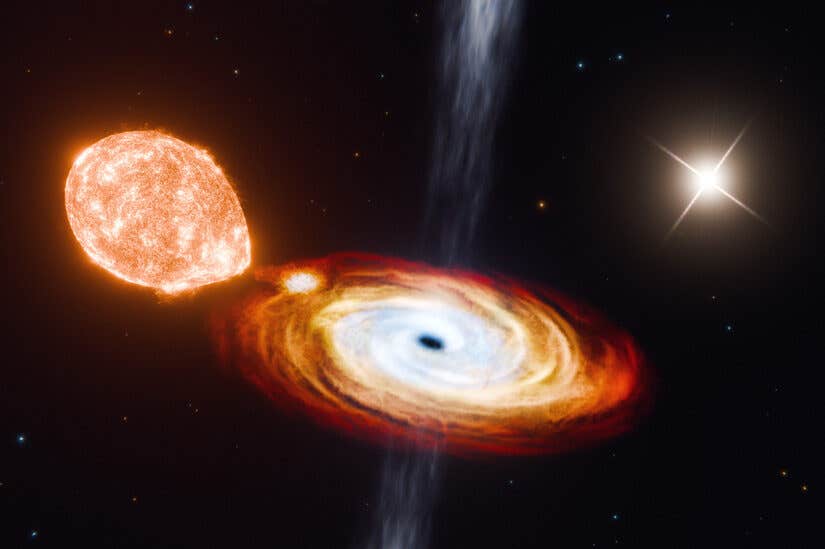First-ever Triple Black Hole discovery upends existing theories
A rare black hole triple system challenges existing theories of black hole formation, suggesting gentler processes than previously believed.

Depicted in this artist’s rendering is the central black hole, V404 Cygni (black dot), in the process of consuming a nearby star (orange body at left), while a second star (upper white flash) orbits at a much farther distance. (CREDIT: Jorge Lugo)
Scientists have long observed black holes existing as part of binary systems, where a black hole pairs with a nearby object like a star, neutron star, or another black hole. These binary partners orbit each other, bound by the black hole’s gravity. However, a recent discovery is shaking up our understanding of black hole formation and evolution.
Physicists from MIT and Caltech have identified a system that is not just a binary but a "black hole triple." The system features a central black hole, much like a binary system, but with two orbiting stars instead of one. One star is close to the black hole, completing its orbit every 6.5 days, while the second star is much farther out, taking a staggering 70,000 years to make one full orbit.
This discovery, published in Nature, is groundbreaking because it challenges the conventional understanding of how black holes form. Typically, black holes result from the explosion of a dying star, known as a supernova. The star collapses inward, creating a black hole, but not before releasing a massive amount of energy. This explosive process is so violent that any loosely bound objects around the star would be thrown out of orbit.
However, the fact that the distant star is still gravitationally bound to the black hole suggests that this black hole didn’t form through a typical supernova. Instead, the team behind the discovery, led by Kevin Burdge, a Pappalardo Fellow at MIT, believes the black hole might have formed through a gentler process known as "direct collapse." In this process, a star caves in on itself without a dramatic explosion, allowing any distant objects to remain in orbit.
Burdge explains the significance of the discovery: “We think most black holes form from violent explosions of stars, but this discovery helps call that into question. This system is super exciting for black hole evolution, and it also raises questions of whether there are more triples out there.”
Related Stories
The new findings suggest that black holes can form through different processes than previously thought. If direct collapse is indeed responsible for this black hole’s formation, it opens up the possibility that other black holes might have formed the same way, with their origins hidden from the dramatic explosions astronomers typically observe.
This black hole triple system, V404 Cygni, located about 8,000 light-years away in the Milky Way galaxy, is already well-known to scientists. Discovered in 1992, it was one of the first objects to be confirmed as a black hole. Since then, it has been extensively studied, appearing in over 1,300 scientific papers. But none of those studies noted the presence of the far-off companion star that Burdge and his team identified.
The breakthrough came while the team was using Aladin Lite, an online tool that allows astronomers to view images from telescopes across the globe. Burdge was reviewing images of V404 Cygni when he noticed two distinct blobs of light. The first blob was already known to represent the black hole and its close companion star, which is so close that it’s shedding material onto the black hole. But the second blob had gone uninvestigated—until now.
Burdge calculated that the distant star was about 3,500 astronomical units (AU) from the black hole. To put that into perspective, one AU is the distance between the Earth and the Sun. This means the outer star is 3,500 times farther from the black hole than Earth is from the Sun, or roughly 100 times the distance between Pluto and the Sun. This incredible distance further supports the idea that the black hole could not have formed through a violent supernova.
To confirm that the two stars were gravitationally bound to the black hole, the team turned to Gaia, a satellite that has been tracking the movements of stars since 2014. The researchers analyzed data from the last ten years and found that both stars moved in tandem with each other, providing strong evidence that they are part of the same system. The odds of this tandem motion occurring by chance are one in 10 million, according to Burdge.
“It’s almost certainly not a coincidence or accident,” Burdge says. “We’re seeing two stars that are following each other because they’re attached by this weak string of gravity. So this has to be a triple system.”
The next question was how this unusual system formed. Burdge and his colleagues ran simulations to explore possible scenarios. They modeled the formation of the black hole and its effects on the two stars under different conditions. In the vast majority of simulations, the only scenario that explained the system’s current configuration was a direct collapse. This gentle process wouldn’t have disturbed the far-off star, allowing it to remain gravitationally bound to the black hole.
The discovery of this black hole triple is also shedding light on the system’s age. The outer star is currently transitioning into a red giant, a phase that occurs near the end of a star’s life. Based on this observation, the researchers estimate that the system is about 4 billion years old. This is significant because it gives astronomers rare insight into the history of an old black hole.
“We’ve never been able to do this before for an old black hole,” Burdge says. “Now we know V404 Cygni is part of a triple, it could have formed from direct collapse, and it formed about 4 billion years ago, thanks to this discovery.”
The research opens new doors for astronomers as they search for more black hole triples and reconsider how these mysterious objects form and evolve. It also raises intriguing questions about how many other black holes could have formed through direct collapse, potentially changing our understanding of stellar evolution.
Note: Materials provided above by The Brighter Side of News. Content may be edited for style and length.
Like these kind of feel good stories? Get The Brighter Side of News' newsletter.
Joshua Shavit
Science & Technology Writer | AI and Robotics Reporter
Joshua Shavit is a Los Angeles-based science and technology writer with a passion for exploring the breakthroughs shaping the future. As a contributor to The Brighter Side of News, he focuses on positive and transformative advancements in AI, technology, physics, engineering, robotics and space science. Joshua is currently working towards a Bachelor of Science in Business Administration at the University of California, Berkeley. He combines his academic background with a talent for storytelling, making complex scientific discoveries engaging and accessible. His work highlights the innovators behind the ideas, bringing readers closer to the people driving progress.



